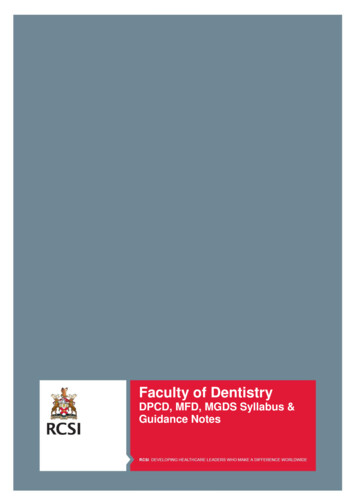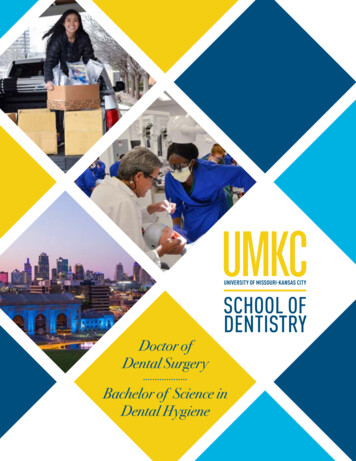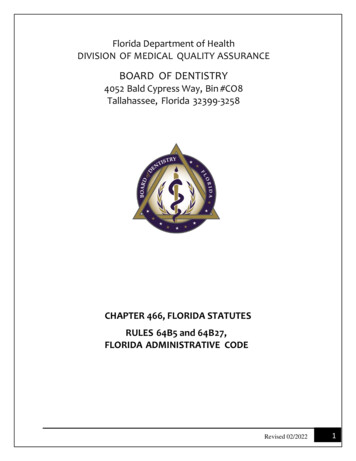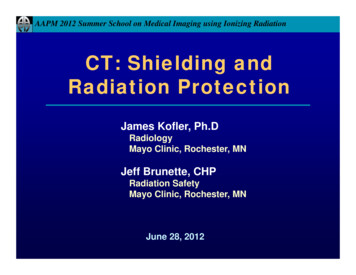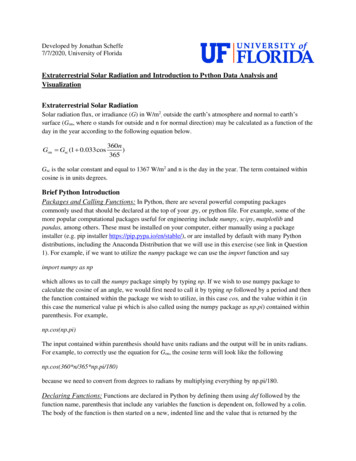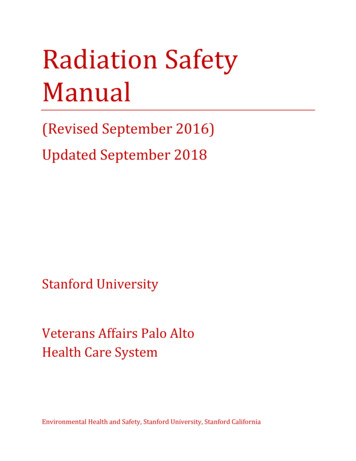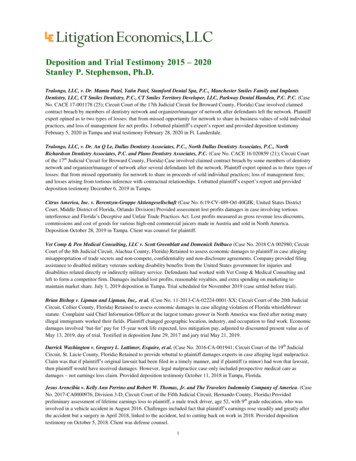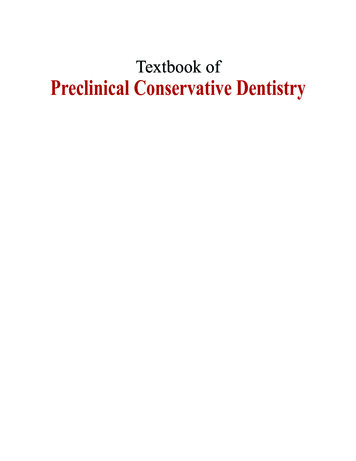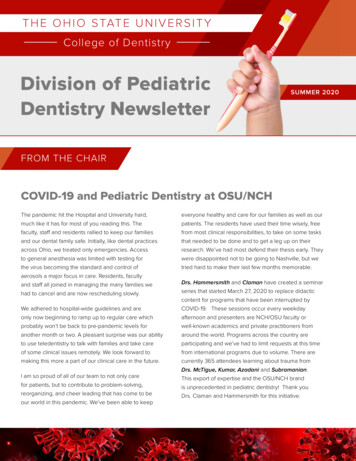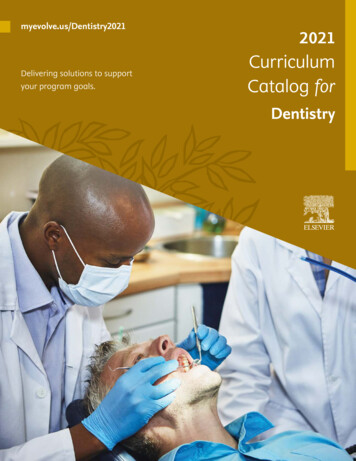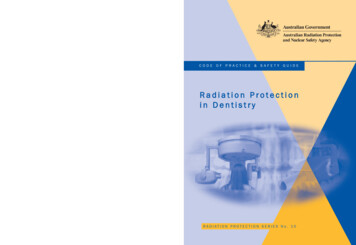
Transcription
RPS 10Code of Practice and Safety Guide for Radiation Protection in DentistryISBN 0-9758169-1-8ISSN 1445-9760CODE OF PRACTICE & SAFETY GUIDERadiation Protectionin DentistryR A D I AT I O N P R OT E C T I O N S E R I E S N o . 10
Radiation Protection SeriesThe Radiation Protection Series is published by the Australian RadiationProtection and Nuclear Safety Agency (ARPANSA) to promote practices whichprotect human health and the environment from the possible harmful effects ofradiation. ARPANSA is assisted in this task by its Radiation Health and SafetyAdvisory Council, which reviews the publication program for the Series andendorses documents for publication, and by its Radiation Health Committee, whichoversees the preparation of draft documents and recommends publication.There are four categories of publication in the Series:Radiation Protection Standards set fundamental requirements for safety. Theyare prescriptive in style and may be referenced by regulatory instruments in State,Territory or Commonwealth jurisdictions. They may contain key proceduralrequirements regarded as essential for best international practice in radiationprotection, and fundamental quantitative requirements, such as exposure limits.Codes of Practice are also prescriptive in style and may be referenced byregulations or conditions of licence. They contain practice-specific requirements thatmust be satisfied to ensure an acceptable level of safety in dealings involvingexposure to radiation. Requirements are expressed in ‘must’ statements.Recommendations provide guidance on fundamental principles for radiationprotection. They are written in an explanatory and non-regulatory style and describethe basic concepts and objectives of best international practice. Where there arerelated Radiation Protection Standards and Codes of Practice, they are basedon the fundamental principles in the Recommendations.Safety Guides provide practice-specific guidance on achieving the requirements setout in Radiation Protection Standards and Codes of Practice. They arenon-prescriptive in style, but may recommend good practices. Guidance is expressedin ‘should’ statements, indicating that the measures recommended, or equivalentalternatives, are normally necessary in order to comply with the requirements of theRadiation Protection Standards and Codes of Practice.In many cases, for practical convenience, prescriptive and guidance documents whichare related to each other may be published together. A Code of Practice and acorresponding Safety Guide may be published within a single set of covers.All publications in the Radiation Protection Series are informed by publiccomment during drafting, and Radiation Protection Standards and Codes ofPractice, which may serve a regulatory function, are subject to a process ofregulatory review. Further information on these consultation processes may beobtained by contacting ARPANSA.
CODE OF PRACTICE & SAFETY GUIDERadiation Protection in DentistryRadiation Protection Series Publication No. 10December 2005This publication was approved by the Radiation Health Committee on10 November 2005 and on 19 December 2005 theRadiation Health & Safety Advisory Council, advised the CEOto adopt the Code of Practice and Safety Guide.
NOTICE Commonwealth of Australia 2005This work is copyright. You may download, display, print and reproducethis material in unaltered form only (retaining this notice) for yourpersonal, non-commercial use or use within your organisation. Apart fromany use as permitted under the Copyright Act 1968, all other rights arereserved. Requests and inquiries concerning reproduction and rightsshould be addressed to:Commonwealth Copyright AdministrationAttorney-General’s DepartmentRobert Garran OfficesNational CircuitCanberra ACT 2600URL: www.ag.gov.au/ccaEmail: commonwealth.copyright@ag.gov.auRequests for information about the content of this publication should beaddressed to the Secretariat, ARPANSA, 619 Lower Plenty Road, Yallambie,Victoria, 3085 or by e-mail to secretariat@arpansa.gov.au.ISBN 0-9758169-2-6ISSN 1445-9760The mission of ARPANSA is to provide the scientific expertise and infrastructurenecessary to support the objective of the ARPANS Act — to protect the health andsafety of people, and to protect the environment, from the harmful effects ofradiation.Published by the Chief Executive Officer of ARPANSA in December 2005
ForewordThis Code of Practice and Safety Guide for Radiation Protection in Dentistryestablishes regulatory requirements for adoption by Australian jurisdictions togetherwith supporting guidance. The Code and Safety Guide were prepared by a workinggroup of the Radiation Health Committee. The Radiation Health Committee,established under the ARPANS Act (1998), is charged with developing policies andpreparing draft publications, including codes and standards, related to radiationprotection. Radiation Health Committee members include radiation control officersfrom each State and Territory, independent experts and a person who represents theinterests of the general public. The working group that developed the Code andSafety Guide included representatives of the Australian Dental Association.The Code and Safety Guide replace the National Health and Medical ResearchCouncil’s Code of Practice for Radiation Protection in Dentistry (1987), RadiationHealth Series No. 20.While the doses delivered by dental X-ray equipment to individual patients are small,the number of dental radiographs taken is large, and so radiation protection is aconsideration for occupational exposure, and for the population through exposure asdental patients.The Code establishes the responsibilities of those involved in dental radiology, andlays down requirements for equipment and siting, image receptors and filmprocessing, and procedures to minimise exposure to ionizing radiation. The SafetyGuide provides advisory and explanatory material that will assist dentists, dentalauxiliaries and staff in meeting the requirements of the Code.The Code will be proposed for adoption nationally into regulatory frameworks by itsinclusion in Schedule 11 of the National Directory for Radiation Protection. TheDirectory provides an agreed uniform framework for radiation protection to beadopted by the Commonwealth, States and Territories.The Code was released for public comment from 29 July 2005 to 16 September 2005with a draft Regulatory Impact Statement, to meet the requirements of the Principlesand Guidelines for National Standard-setting and Regulatory Action by MinisterialCouncils and Standard Setting Bodies, published by the Council of AustralianGovernments in June 2004. The comments were reviewed by the working group andthe final Code was approved by the Radiation Health Committee on 10 November2005. The final Regulatory Impact Statement was cleared by the CommonwealthOffice of Regulation Review on 9 November 2005. The Radiation Health and SafetyAdvisory Council advised the CEO to adopt the Code and Safety Guide on19 December 2005.John LoyCEO of ARPANSA20 December 2005i
(This page intentionally left blank)
ContentsForeword . iCode of Practice . 1Safety Guide . 37Contributors to Drafting and Review.61Index . 62iii
(This page intentionally left blank)
CODE OF PRACTICERadiation Protection in DentistryRadiation Protection Series Publication No. 10
(This page intentionally left blank)
Code of Practice Contents1.Introduction . 51.11.21.31.41.52.CITATION . 5BACKGROUND . 5PURPOSE . 5SCOPE . 5STRUCTURE . 6Responsibilities .7Type and frequency of radiographic examination indental practice . 123.1 CLINICAL ASSESSMENT OF THE NEED FOR RADIOGRAPHY . 123.2 RESEARCH PROJECTS INVOLVING THE IRRADIATION OF HUMANS .124.Equipment and site requirements . 134.1COMPLIANCE WITH AUSTRALIAN STANDARDS AND REGULATORYAUTHORITY REQUIREMENTS . 134.2 LOCATION OF X-RAY UNITS AND PROVISION OF STRUCTURALSHIELDING . 135.Image receptors and film processing . 145.15.25.35.45.55.66.Code of PracticeRadiation Protection in Dentistry2.1 RESPONSIBILITIES OF THE RESPONSIBLE PERSON. 72.2 RESPONSIBILITY OF THE CLINICIAN OPERATING THE DENTALX-RAY EQUIPMENT . 92.3 RESPONSIBILITIES OF THE REFERRER FOR RADIOGRAPHICEXAMINATION . 102.4 RESPONSIBILITIES OF PERSONS SUPPLYING, INSTALLING ANDSERVICING DENTAL X-RAY EQUIPMENT. 102.5 COMPLIANCE TESTING OF X-RAY EQUIPMENT . 113.RadiationProtectionSeriesNo. 10DIGITAL IMAGING SYSTEMS. 14FILM SIZES AND APPLICATIONS . 14USE OF HIGH SPEED FILM. 14STORAGE OF UNEXPOSED FILMS . 14PROCESSING OF FILMS .14QUALITY ASSURANCE OF PROCESSING . 15Procedures to minimise exposure to ionizing radiation . 166.16.26.36.4USE OF EXPOSURE CHARTS .16PERSONS IN THE ROOM DURING RADIOGRAPHY .16EXPOSURE TO THE PRIMARY X-RAY BEAM .16HOLDING OF IMAGE RECEPTOR AND STANDARDISATION OFTECHNIQUE BY USING IMAGE RECEPTOR HOLDERS .166.5 HOLDING OF X-RAY UNIT.166.6 HOLDING OF PATIENTS . 176.7 POSITION OF OPERATOR DURING EXPOSURE . 176.8 PERSONAL MONITORING . 173
RadiationProtectionSeriesNo. 10Schedule 1ARPANSA’s Recommendations for limitingexposure to ionizing radiation (2002) –Dose Limits . 18Schedule 2 Minimum Requirements for Existing DentalX-ray Equipment .19References and Further Reading . 24Code of PracticeRadiation Protection in DentistryGlossary. 264Annex 1Regulatory Authorities . 29Annex 2Use and Processing of Dental Films . 30
No. 10This Code may be cited as the Code of Practice for Radiation Protection inDentistry (2005).1.2BACKGROUNDRadiology plays an essential part in dental health practice and clinicians whoadvise patients to undergo X-ray examinations must be aware of the natureof any possible harmful effects and of the risks involved (see Safety Guide,Annex A for further information). If the principles and practices set out inthis Code are adopted a satisfactory radiograph should be obtained with aminimum exposure to radiation of the patient, the clinician and otherpersons involved with the examination.1.3PURPOSEThis Code has been prepared to establish practices and procedures in the useof ionizing radiation in dentistry that will ensure that the risk of radiationexposure to the patient, clinician and other persons is minimised.Code of PracticeRadiation Protection in DentistryThis Code of Practice replaces an earlier code entitled Code of Practice forRadiation Protection in Dentistry (1987) published by the National Healthand Medical Research Council, following its one hundred and third session inJune 1987.This Code lays down detailed requirements for the following protectivemeasures: allocation of responsibility;need for clinical assessment of the indications for radiography;provision of appropriate equipment, film and processing facilities;adoption of procedures to minimise exposure to radiation.The Code is intended to be used as a supplement to the relevant radiationcontrol regulations applicable in the States and Territories and theCommonwealth (see Annex 1 for details of Radiation Protection Authorities).Where there is a conflict between this Code and the legislation of the States,Territories or the Commonwealth, the provisions of the legislation prevail.1.4SCOPEThis Code applies to the Responsible Person1 and to any person performingor assisting with a dental radiographic examination (e.g. dentists,radiographers, dental therapists, dental hygienists and dental assistants withextended duties) in dental practice, and to persons supplying, installing andservicing dental X-ray equipment.1See glossary5
Code of PracticeRadiation Protection in DentistryRadiationProtectionSeriesNo. 10This Code deals with radiographic procedures used in general and specialistdental practice, including: intra-oral radiography: periapical, bitewing and occlusal views;panoramic radiography;cephalometry;radiography using specialised dental CT equipment;other forms of radiography of the complete skull or certain parts of thedento-maxillofacial region;hand and wrist radiography for the purpose of the determination of thebone age.Certain of the above procedures may be restricted or have special licensingrequirements in some jurisdictions. Licensees may be restricted topossessing specified types of dental X-ray equipment and/or performingspecified types of radiographic examinations. Licences for differentcategories of staff may specify different responsibilities for each category.1.5STRUCTUREThe Code of Practice sets out requirements to be met to achieve asatisfactory level of radiation protection. It sets out material that may beadopted by State, Territory and Commonwealth regulatory authorities aspart of their regulatory controls, and in conditions of licence or registrationassociated with the use of ionizing radiation within their jurisdiction.Schedules set out additional information that form part of the Code ofPractice, and are therefore part of the material adopted and enforced byregulatory authorities.Material in the Annexes is advisory material for clarification and guidanceonly. It does not form part of the Code that may be adopted by regulatoryauthorities.6
2.Responsibilities2.1RESPONSIBILITIES OF THE RESPONSIBLE PERSONRadiationProtectionSeriesNo. 102.1.1 The responsibility for radiation protection lies with the person (theResponsible Person for the purposes of this Code) in control of theinstitution, department or practice using the dental X-ray equipment.2.1.3 The Responsible Person must ensure that radiation doses:(a) are kept as low as reasonably achievable; and(b) do not exceed the appropriate dose limits specified in Schedule 1.2.1.4 The Responsible Person must appoint a Radiation Safety Officer (whomay also be the Responsible Person) who has sufficient professional and/ortechnical training to:(a) supervise radiation protection in order to minimise personalradiation doses;(b) advise staff on safe working practices in accordance with alllegislation and codes of practice;(c) consult and liaise with the regulatory authority;(d) ensure that all relevant regulatory matters are duly processed;Code of PracticeRadiation Protection in Dentistry2.1.2 The Responsible Person must be familiar with all requirements of theregulatory authority including registration, licensing, controlled orsupervised radiation areas, monitoring, recording of personal doses,reporting, surveying, maintenance and quality control checks.(e) arrange for monitoring of areas, equipment and operations asrequired;(f)ensure that suitable personal monitoring devices are providedwhere required and properly used;(g) arrange for dose records, where determined for individuals, to bekept;(h) record and report to the Responsible Person and the appropriateauthorities any unsafe practices or accidents;(i)investigate any radiation incidents;(j)maintain current records of all irradiating apparatus andlocations;(k) arrange for any records required by sub-clause (j) to be kept for aperiod specified in this Code;(l)provide advice, instruction and local rules on radiation safety inan easily understandable form and at an adequate level forpersons involved in dental radiography;(m) perform any other tasks that may be necessary to maintain a highstandard of radiation safety in the establishment; and7
RadiationProtectionSeriesNo. 10(n) determine which staff are to beoccupationally exposed to radiation’.designated‘persons2.1.5 The Responsible Person must ensure that the Radiation Safety Officerhas the authoritative standing to implement this Code.Code of PracticeRadiation Protection in Dentistry2.1.6 The Responsible Person must provide personal monitoring for allstaff involved in radiography, unless a radiation safety assessmentdemonstrates that doses are not significant and, where required, anexemption is granted by the regulatory authority.2.1.7 The Responsible Person must keep radiation dose records foremployees’ doses assessed during the period of employment.2.1.8 The Responsible Person must ensure that radiation dose records areavailable for inspection by:(a) the individual to whom the record applies; and(b) the regulatory authority.2.1.9 In order to avoid unnecessary radiation doses, the ResponsiblePerson must ensure that radiographic images and adequate records are keptfor a period of at least 7 years unless the radiographic images are sent toanother practitioner. In the case of minors the records must be kept for aminimum of 7 years after they reach adulthood (18 years of age).2.1.10 The Responsible Person must determine the work procedures that arenecessary to enable the implementation of this Code.2.1.11 The Responsible Person must provide all the facilities and/orequipment that are necessary to enable the implementation of this Code.2.1.12 The Responsible Person must ensure that:(a) the use of dental X-ray equipment constitutes minimal risks topatients, operators and other staff in the practice as well as topersons who are in or near the premises where the dental X-rayequipment is installed.(b) the installation and operation of dental X-ray equipmentcomplies with the regulations of the relevant State, Territory orCommonwealth jurisdiction. In most jurisdictions, this includesensuring that the dental X-ray equipment is used only byoperators holding appropriate licences.(c) adequate X-ray viewing conditions and adequate film orelectronic image processing and archiving conditions areprovided.(d) X-ray equipment and processing equipment undergomaintenance on a regular basis and complies with theregulations of the relevant State, Territory or Commonwealthjurisdiction and with the recommendations of themanufacturers.8
2.1.13 The Responsible Person must ensure that, where required, plans forbuildings that are to incorporate dental radiographic facilities, includingdetails of any shielding, are submitted to the regulatory authority beforecommissioning.RadiationProtectionSeriesNo. 102.1.14 The Responsible Person, in consultation with the regulatory authority,must ensure that appropriate radiation safety assessments are made by anappropriately qualified person for the following circumstances:(a) before the dental X-ray equipment is put into routine use;(c) where personal monitoring indicates that the doses received byany person exceed, or are likely to exceed the appropriate doselimits or are higher than normal for no obvious reason, or arehigher than average doses received in similar departments andpractices;(d) where changes are to be made in the immediate environs thatmay result in an increase of occupancy3;(e) where an increase in workload in the department or practice isanticipated; or(f)whenever any servicing is carried out on the X-ray tube assembly.2.1.15 If at any time a radiation safety assessment indicates that any personhas or may have received doses in excess of the relevant effective dose limits,or the relevant dose constraints established, the Responsible Person mustnotify the regulatory authority.2.2 RESPONSIBILITY OF THE CLINICIAN OPERATINGDENTAL X-RAY EQUIPMENTCode of PracticeRadiation Protection in Dentistry(b) where the dental X-ray equipment is to be replaced or modified,or working procedures are to be modified2;THE2.2.1 Where the clinician operating the dental X-ray equipment is a dentist,the dentist must ensure that radiological examinations are carried outproperly at all times during the course of dental treatment.Thisresponsibility covers the following components of the examination:(a) determination of clinical need for the examination(b) selection of the most appropriate method of examination(c) optimising radiographic techniques(d) the use of optimal film or electronic image processing techniques(e) interpretation of radiographs(f)maintenance of radiographic records.2.2.2 Where, if permitted by legislation of the relevant State, Territory orthe Commonwealth, some of the components of conducting an2‘Modified’ means a change in the amount of radiation, the manner of its use or a changein the X-ray equipment or its location. Such modifications may mean the originalprotection is no longer adequate.3An example would be a store or waiting area becoming an office.9
RadiationProtectionSeriesNo. 10examination are undertaken by another appropriately authorisedperson, such as a dental therapist, dental hygienist or dentalassistant:(a) the dentist must remain ultimately responsible for overallpatient care;Code of PracticeRadiation Protection in Dentistry(b) staff undertaking aspects of radiographic examination under thisclause are properly trained and that work practices of all staffinvolved with radiological examinations are reviewed on aregular basis; and(c) the restrictions and responsibilities as specified in the legislationof the relevant State or Territory apply.2.3 RESPONSIBILITIES OF THE REFERRER FOR RADIOGRAPHICEXAMINATIONIn cases where patients are referred for radiographic examination, thereferrer must provide clinical notes. These notes must contain both thereason for the radiographic examination as well as an adequate history. Ifany radiographs were taken in relation to the condition prior to the referral,these or the reports must also be included where relevant.2.4 RESPONSIBILITIES OF PERSONS SUPPLYING, INSTALLINGAND SERVICING DENTAL X-RAY EQUIPMENT2.4.1 The supplier is responsible for ensuring that:(a) dental X-ray equipment complies with the relevant AustralianStandards and any equipment requirements of the regulatoryauthority; and(b) the purchaser is authorised by the regulatory authority topossess dental X-ray equipment.2.4.2 The person installing, repairing or modifying dental X-ray equipmentmust:(a) be licensed, where required by the regulatory authority;(b) ensure that the setting for the image receptor sensitivity of newlyinstalled, serviced or modified equipment complies with thesensitivity of the most frequently used image receptors;(c) ensure that X-ray equipment fitted with an object programmedexposure control (i.e. where the user selects the exposure froman icon showing a representation of the tooth or part to beexamined) is adjusted to match the speed of the image receptorin use; and(d) set any default parameters for digital imaging so that theminimum exposure that is needed to obtain a satisfactory imageis used.10
2.5 COMPLIANCE TESTING OF X-RAY EQUIPMENT2.5.1 The regulatory authority may require X-ray equipment to be testedand certified to be in compliance with the relevant standards and localregulations prior to its use on humans. Persons undertaking these tests mustbe licensed or otherwise authorised by the relevant regulatory authority listedin Annex 1.Code of PracticeRadiation Protection in Dentistry2.5.2 Where compliance testing of dental X-ray equipment at regularintervals is required by the regulatory authority, the Responsible Personmust ensure that testing is carried out at the prescribed intervals.RadiationProtectionSeriesNo. 1011
RadiationProtectionSeriesNo. 103.Type and frequency of radiographicexamination in dental practice3.1CLINICAL ASSESSMENT OF THE NEED FOR RADIOGRAPHYCode of PracticeRadiation Protection in Dentistry3.1.1 The nature and extent of an actual or a suspected dental condition, itsearly detection, treatment and response to treatment must be the primarydetermining factors in submitting the patient to radiographic examination.3.1.2 Radiology must not be used as a substitute for a clinical investigation,and therefore radiography must not be undertaken until a medical historyhas been taken and a clinical examination has established the need for aradiological examination, unless an emergency situation dictates otherwise.3.1.3 Radiology is a most valuable aid to oral diagnosis, but it must beemployed in accordance with the dental and general health needs of theindividual patient.3.2 RESEARCH PROJECTS INVOLVINGHUMANSTHEIRRADIATIONOF3.2.1 Where a project is to be undertaken for research purposes on humansthe research must conform to generally accepted ethical and scientificprinciples.3.2.2 To be medically justified, the information gained must be used toaffect the care of people discovered to have a particular condition. For eachproject, there must be full compliance with the NHMRC’s NationalStatement on Ethical Conduct in Research Involving Humans (1999) andthe requirements of ARPANSA’s Code of Practice for Exposure of Humansto Ionizing Radiation for Research Purposes, Radiation Protection SeriesPublication No. 8 (2005).3.2.3 Such projects must be so designed that the frequency of radiographicexaminations and the number of images per examination is the minimumnecessary and every effort must be made to provide the individual patientwith some direct benefit from the examinations made. Recommended doseconstraints apply in cases where there is no direct benefit to volunteers.12
4.Equipment and site requirements4.1COMPLIANCE WITH AUSTRALIAN STANDARDSREGULATORY AUTHORITY REQUIREMENTSANDRadiationProtectionSeriesNo. 104.1.1 New dental X-ray equipment must be of a type registered by theTherapeutic Goods Administration (TGA), and comply with the specificationsof Australian Standard AS/NZS 3200.2.2014, which applies to the followingX-ray equipment used for general and specialist dental practice:(b) X-ray equipment for panoramic radiography; and(c) dedicated cephalometric X-ray equipment.4.1.2 Dental X-ray equipment which is in use at the time of introduction ofthis Code, and which does not comply with the relevant requirements ofAS/NZS 3200.2.2014, must be modified to comply with the requirementsspecified in Schedule 2, except where otherwise approved by the regulatoryauthority, or phased out of use on a time scale approved by the regulatoryauthority. Note that it may not be practical to modify some old equipment.4.1.3 Dental X-ray equipment must not be used for fluoroscopy.4.1.4 Equipment designed for intra-oral radiography must not be used forany other type of radiographic examination. Radiography of the mandible,including temporo-mandibular joints, must be conducted only on generalpurpose medical X-ray equipment or on special purpose equipment designedfor such examinations unless otherwise authorised by the regulatoryauthority.Code of PracticeRadiation Protection in Dentistry(a) X-ray equipment for use with intra-oral image receptors;4.1.5 Hand and wrist radiography (which may be required for bone agedetermination) must only be performed on medical X-ray equipment or onspecial purpose equipment designed for such examinations, and operated byappropriately trained and licensed persons.4.1.6 General purpose medical X-ray equipment must not be used forintra-oral dental radiography.4.2 LOCATION OF X-RAY UNITSSTRUCTURAL SHIELDINGANDPROVISIONOF4.2.1 The Responsible Person must ensure that there is appropriateradiation shielding in the room where X-ray procedures are performed andappropriate shielding for operators, such that no person receives a radiationdose in excess of the relevant dose limit.4.2.2 Approval for the structural shielding and other radiation safetymeasures may be required by the regulatory authority before X-rayequipment is used on humans. The Responsible Person must ensure thatthis approval is obtained where required.4 Equipment such as specialised dental CT equipment is not included in this Standard, or inSchedule 2 of this Code. Its use is subject to the
exposure to radiation. Requirements are expressed in 'must' statements. Recommendations. provide guidance on fundamental principles for radiation protection. They are written in an explanatory and non-regulatory style and describe the basic concepts and objectives of best international practice. Where there are related . Radiation .
